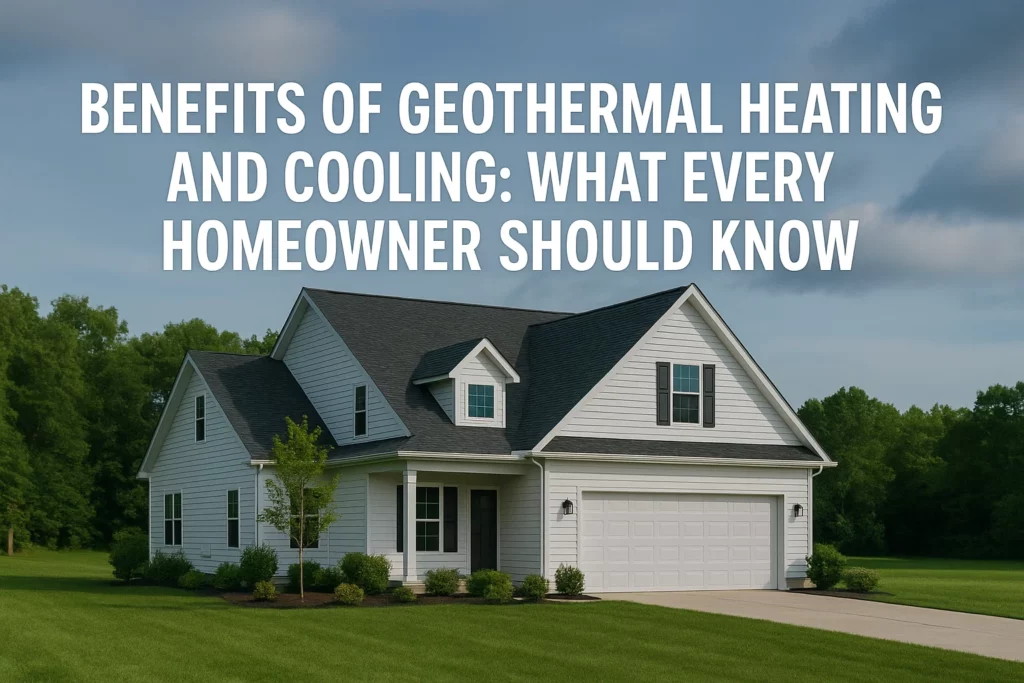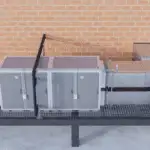“An investment in knowledge pays the best interest.”
— Benjamin Franklin
If there’s one thing I’ve learned after 15 years in the HVAC industry, it’s this: comfort doesn’t have to come at the cost of efficiency or the environment. That’s exactly why more homeowners are turning to geothermal heating and cooling systems.
In this blog, I’ll walk you through the real-world benefits of geothermal heating and cooling, clear up common misconceptions, and share a few honest thoughts on the geothermal HVAC pros and cons I’ve seen in the field.
Key Takeaways
- Geothermal systems offer up to 70% energy savings compared to traditional HVAC.
- They last longer, operate quietly, and are eco-friendly.
- While installation costs can be high, federal and state rebates ease the investment.
- Not all properties are ideal—soil conditions and available space matter.
- Maintenance is minimal, but proper design is critical to avoid future geothermal problems.
What Is Geothermal Heating and Cooling?
Geothermal heating and cooling taps into the stable temperature below the earth’s surface—around 55°F year-round—using a ground-source heat pump to heat and cool your home.
This system circulates water or a refrigerant through underground loops, transferring energy to or from your home depending on the season.
Think of it as using the earth’s natural thermostat to stay comfortable indoors—year-round.
The Real Benefits of Geothermal Heating and Cooling
1. Massive Energy Savings
Let’s cut to the numbers. A geothermal system can reduce your heating costs by up to 70% and cooling costs by up to 50%. Why? Because it’s moving heat—not creating it.
Real-World Scenario:
One of my clients in Michigan slashed their $350 winter energy bill to just under $100 after installing a closed-loop geothermal system.
Their return on investment? Just under six years.
2. Long-Term Cost Efficiency
While the upfront cost can range from $18,000 to $30,000, these systems last significantly longer than traditional HVAC systems.
The indoor heat pump unit often lasts 20–25 years, while the ground loop system can last up to 50 years.
Bonus Point
Add in the federal tax credit (currently up to 30%), and the payback period gets even shorter.
3. Quiet, Comfortable Operation
There are no noisy outdoor compressors or fans in geothermal systems. The only moving parts are inside, making them whisper-quiet—especially important for homes in suburban neighborhoods or for light sleepers. Read more: How Much Does Heating and Cooling Cost?
Environmental Benefits of Geothermal Heating and Cooling
As someone who works with furnaces, A/C units, and boilers daily, I’ve seen how much energy traditional systems burn—and how much they emit. Geothermal systems reduce your home’s carbon footprint by up to 50%.
According to the U.S. Department of Energy, installing a single geothermal system is equivalent to planting 750 trees or removing two cars from the road.
As Jane Goodall said,
“What you do makes a difference, and you have to decide what kind of difference you want to make.”
Geothermal Heating and Cooling Pros and Cons
I won’t sugarcoat it—geothermal isn’t right for everyone. Here’s a straight look at what works (and what doesn’t).
Pros
- Energy Efficient: Up to 4x more efficient than gas or electric systems.
- Low Operating Cost: You’ll see a consistent drop in your monthly utility bills.
- Eco-Friendly: No onsite combustion means zero emissions.
- Durability: Ground loops outlast almost every other home system.
- Incentives: Federal, state, and utility rebates make installation more affordable.
Cons
- High Upfront Cost: It’s not a small investment.
- Not Ideal for All Lots: Limited yard space or rocky terrain can complicate install.
- Requires Expertise: Poorly installed systems can result in long-term geothermal problems like leaks, inefficiency, or uneven heating.
- Electrical Dependency: In case of a blackout, backup systems may be necessary.
Things to Consider Before Installing Geothermal HVAC
Soil and Land
Do you have enough space for horizontal loops, or will you need a more expensive vertical system? Soil composition, water table, and rock depth all matter.
HVAC Load
Have you had a Manual J load calculation done? Oversizing or undersizing the system can lead to inefficiency and comfort issues.
Budget
What rebates, tax credits, or local incentives are available? In many states, homeowners qualify for energy-efficiency grants and financing plans.
Real World Scenarios
Scenario 1: Family of Four in a 3,000 Sq. Ft. Home
They switched from propane heating and window A/C units to a full geothermal HVAC system. Their average energy bills dropped from $400/month to $120/month. Over ten years, they’re saving nearly $34,000—and the comfort level went through the roof.
Scenario 2: Small Business Office in a Converted Home
We installed a vertical loop geothermal system in a tight city lot. The owner loved the low maintenance, quiet operation, and how they could market the building as “green-powered” to attract eco-conscious clients.
Note on Common Geothermal Problems
Even the best technology can run into issues if not installed or maintained properly.
- Airlocks in the loop system can reduce efficiency.
- Leaks in underground piping are rare but costly if not detected early.
- Incorrect thermostat settings often lead to short cycling or poor dehumidification.
- Poorly sized systems will struggle to meet temperature demands in extreme weather.
This is why it’s crucial to work with a certified and experienced HVAC team. (Spoiler: that’s us at High Comfort.)
Disclaimer
Geothermal systems aren’t one-size-fits-all. A proper site assessment, soil analysis, and heat load calculation are essential before investing. Always consult a licensed geothermal HVAC contractor.
Final Thoughts: Is Geothermal Right for You?
If you’re planning long-term, want a cleaner environmental footprint, and are tired of fluctuating energy bills, the benefits of geothermal heating and cooling are hard to ignore. It’s efficient, quiet, and built to last—perfect for homeowners looking for peace of mind and performance.
Want to explore your options or see if your property qualifies?
Let’s talk. At High Comfort, we bring over 15 years of HVAC experience and have installed dozens of successful geothermal systems across Michigan.
Environmental Benefits of Geothermal Heating and Cooling FAQs
What is the downside of geothermal heating in Michigan?
The main downside of geothermal heating is the high upfront installation cost, which can range from $18,000 to $30,000.
Additionally, it may not be suitable for all properties due to land or soil limitations.
Does geothermal raise the residential electric bills?
While geothermal systems run on electricity, they use far less energy than traditional HVAC systems. So, although electric usage may rise slightly, overall utility bills typically drop significantly.
What are 3 advantages and 3 disadvantages of geothermal energy in Michigan?
Three advantages of geothermal energy in Michigan include its high efficiency with stable ground temperatures, eligibility for state and federal incentives, and long system lifespan with minimal maintenance.
Three disadvantages are the steep upfront cost, potential challenges drilling through rocky soil, and space limitations for loop installation in some properties.




